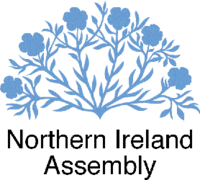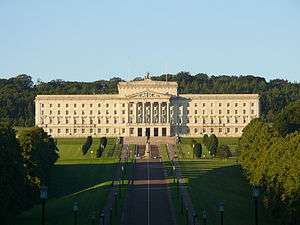Member of the Legislative Assembly (Northern Ireland)

 |
| This article is part of a series on the politics and government of Northern Ireland |
|
Northern Ireland in the EU |
A Member of the Legislative Assembly (MLA) is a representative elected by the voters to the Northern Ireland Assembly in Northern Ireland.
About
The Northern Ireland Assembly has 108 elected members - six from each of 18 constituencies, the boundaries of which are the same as those used for electing members of the UK Parliament. Its role is primarily to scrutinise and make decisions on the issues dealt with by Government Departments and to consider and make legislation.[1]
Responsibilities
MLAs are responsible for the Northern Ireland Assembly.
Salary
The basic salary for an MLA is £48,000 while the Speaker, ministers and committee chairs receive an additional 'Office Holders Salary' on top of their basic salary.[2]
Members do not receive a salary if they are in receipt of a salary from Westminster.[2]
History
Previous similar legislators
From 22 June 1921 until 30 March 1972 MPs of the House of Commons of Northern Ireland and Senators of the Senate of Northern Ireland in the Parliament of Northern Ireland legislated for Northern Ireland like MLAs do today.
Northern Ireland Assembly legislators
Following a referendum on the Belfast Agreement on 23 May 1998 and the granting of Royal Assent to the Northern Ireland Act 1998 on 19 November 1998; a Northern Ireland Assembly and Northern Ireland Executive were established by the Labour government of Prime Minister Tony Blair. The process was known as devolution and was set up to give Northern Ireland devolved legislative powers. MLAs are responsible for the Northern Ireland Assembly.
Members of the Legislative Assembly
- Members of the Northern Ireland Assembly elected in 2016
- Members of the Northern Ireland Assembly elected in 2011
- Members of the Northern Ireland Assembly elected in 2007
- Members of the Northern Ireland Assembly elected in 2003
- Members of the Northern Ireland Assembly elected in 1998
See also
- Northern Ireland Assembly
- Northern Ireland Executive
- Member of the Scottish Parliament
- Member of the National Assembly for Wales
References
- ↑ http://www.niassembly.gov.uk/io/summary/new_summary.htm#2
- 1 2 "Members' Salaries 2013-2014". niassembly.gov.uk.

